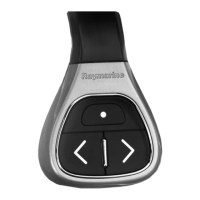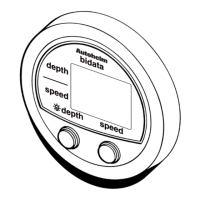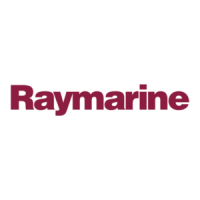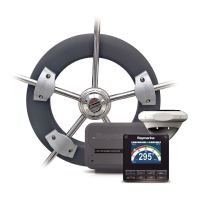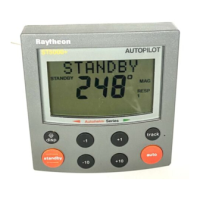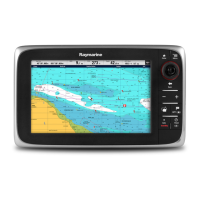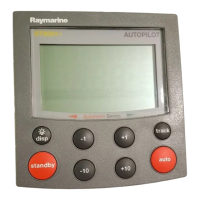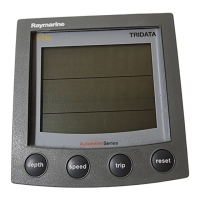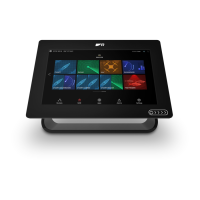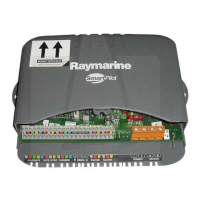Do you have a question about the Raymarine RL70C and is the answer not in the manual?
Overview of the HSB Series LCD display, its controls, and how to use the manual.
Lists key features and capabilities of the HSB Series LCD display unit.
Explains the three full-screen modes (Radar, Chart, Data Log) and half-screen windows.
Describes the radar picture, ship's position, heading marker, and range scales.
Outlines core radar functions like range control, gain, clutter, and target management.
Explains the chartplotter display, scale, vessel position, and chart information.
Describes system operation via on-screen controls like trackpad, soft keys, and dedicated keys.
Explains the dynamic soft keys whose functions change based on the current operation.
Provides detailed instructions for standard radar operations and system setup.
Explains how to view the radar picture at various scales and change the range.
Covers how to interpret radar echoes and adjust controls for optimal display.
Details how to adjust gain, sea clutter, and rain clutter for optimal radar performance.
Explains how to adjust target visibility with interference rejection, expansion, and wakes.
Explains how to use Variable Range Markers and Electronic Bearing Lines for measurements.
Explains how to set up guard zones and handle associated alarms.
Explains how to use and display non-radar information and the MOB function.
Describes how to change the radar picture's orientation mode for better display.
Explains how to place, move, and delete marks on the radar picture.
Details the Man Overboard function for returning to a lost person or object.
Explains how to display chart cursors on radar and vice-versa for identification.
Explains how to use the chart functions for navigation with HSB Series displays.
Details how to use C-MAP NT chart cards for detailed area information.
Describes how new chart information is displayed after inserting a card or changing scale.
Explains how to view information about chart objects, ports, and tide data.
Covers waypoint management, including placing, selecting, editing, and erasing.
Guides users through changing a waypoint's symbol, name, and position.
Covers route creation, saving, clearing, retrieving, and displaying information.
Details the process of creating a new route by placing waypoints.
Explains how to follow routes and navigate to specific points.
Explains how to transfer waypoints and routes between instruments.
Explains how to mark and manage the vessel's trail on the display.
Explains additional functions for chartplotter and combined radar/chartplotter.
Details how to measure distances and bearings on the chart using VRM/EBL.
Explains how to set up and manage various alarms and timers.
Details the Man Overboard function for returning to a lost person or object.
Provides information and status of tracked navigation satellites and GPS setup.
Explains how to log course data and view recorded log entries.
Explains how to set up the display unit for correct operation and preferences.
Guides users through changing system, radar, advanced, and chart setup parameters.
Lists system setup parameters, their options, and factory default settings.
Sets how variation is obtained (Auto or Manual) and displays current value.
Enables display of cursors from other connected displays.
Allows operation of the radar display without data from antenna or external sources.
Allows setup of radar parameters according to system configuration and preferences.
Corrects for display azimuth error to ensure accurate target bearings.
Allows fine-tuning of the radar through display timing, STC preset, and tune preset.
Allows setup of chartplotter parameters for display configuration and preferences.
Enables synchronization of radar and chart images in split-screen mode.
Provides instructions for installing the HSB Series LCD Display.
Guides users on planning the installation, considering siting and cable runs.
Provides guidelines for optimal Electromagnetic Compatibility performance.
Details how to unpack and check all system components.
Offers points to consider for choosing a convenient and interference-free mounting location.
Provides considerations for running power, inter-unit, SeaTalk, HSB, and NMEA cables.
Details power cable requirements and connection for HSB Series displays.
Describes the inter-unit cable for connecting the scanner to the display unit.
Explains how to mount the display unit using trunnion or console options.
Details the process for mounting the display unit using the trunnion bracket.
Provides instructions for console mounting using the optional flush-mounting kit.
Details system grounding, DC power, and external equipment connections.
Explains the importance of proper RF ground connection for the system.
Outlines system tests and alignment procedures after installation.
Corrects for display azimuth error to ensure accurate target bearings.
Details how to adjust display timing to correct for cable length effects.
Provides guidelines to ensure the installation is not affected by external influences.
Explains how to link HSB Series displays with other equipment for data transfer.
Describes the High Speed Bus for rapid data transfer between master and repeater displays.
Explains how to receive comprehensive data via SeaTalk and NMEA.
Outlines checks for chart display, received data, and transmitted data in integrated systems.
Provides information on routine maintenance and safety warnings.
Highlights high voltage hazards and precautions for servicing.
Lists periodical checks for the LCD display and cables.
Provides guidelines for servicing by authorized personnel and handling high voltages.
Explains the different types of system reset available for the Pathfinder Radar.
Offers troubleshooting advice for common problems with the display unit.
Provides a table identifying likely causes and corrective actions for faults.
Provides contact information for Raytheon Marine product and service support in the US.
Lists general specifications for the HSB Series 7" LCD Displays.
Provides details on approvals, size, weight, mounting, power, and environmental ratings.
Lists key features of the radar system, including range scales and accuracy.
Lists features of the chartplotter, including cartography, waypoints, and routes.
Details the interfacing capabilities via High Speed Bus, SeaTalk, and NMEA.
Explains how to connect SeaTalk GPS and beacon receivers using the auxiliary junction box.
Provides connection details for specific GPS models to the chartplotter.
Details connections for Autohelm GPS models and beacon receivers.
Explains connections for the SeaTalk version of the Raystar 112LP GPS.
Details connections for the Raystar 114 GPS and beacon receiver.
Explains how to customize chart feature display using the CUSTOMISE CHART menu.
Details the grouping of chart features controlled by the Customise Chart menu.
Defines data received on NMEA/SeaTalk ports, listing sources and priority.
Details data transmitted by the HSB Series display on SeaTalk and NMEA Out ports.
Details limitations and exclusions applicable to the Raytheon Marine Company warranty.
Overview of the HSB Series LCD display, its controls, and how to use the manual.
Lists key features and capabilities of the HSB Series LCD display unit.
Explains the three full-screen modes (Radar, Chart, Data Log) and half-screen windows.
Describes the radar picture, ship's position, heading marker, and range scales.
Outlines core radar functions like range control, gain, clutter, and target management.
Explains the chartplotter display, scale, vessel position, and chart information.
Describes system operation via on-screen controls like trackpad, soft keys, and dedicated keys.
Explains the dynamic soft keys whose functions change based on the current operation.
Provides detailed instructions for standard radar operations and system setup.
Explains how to view the radar picture at various scales and change the range.
Covers how to interpret radar echoes and adjust controls for optimal display.
Details how to adjust gain, sea clutter, and rain clutter for optimal radar performance.
Explains how to adjust target visibility with interference rejection, expansion, and wakes.
Explains how to use Variable Range Markers and Electronic Bearing Lines for measurements.
Explains how to set up guard zones and handle associated alarms.
Explains how to use and display non-radar information and the MOB function.
Describes how to change the radar picture's orientation mode for better display.
Explains how to place, move, and delete marks on the radar picture.
Details the Man Overboard function for returning to a lost person or object.
Explains how to display chart cursors on radar and vice-versa for identification.
Explains how to use the chart functions for navigation with HSB Series displays.
Details how to use C-MAP NT chart cards for detailed area information.
Describes how new chart information is displayed after inserting a card or changing scale.
Explains how to view information about chart objects, ports, and tide data.
Covers waypoint management, including placing, selecting, editing, and erasing.
Guides users through changing a waypoint's symbol, name, and position.
Covers route creation, saving, clearing, retrieving, and displaying information.
Details the process of creating a new route by placing waypoints.
Explains how to follow routes and navigate to specific points.
Explains how to transfer waypoints and routes between instruments.
Explains how to mark and manage the vessel's trail on the display.
Explains additional functions for chartplotter and combined radar/chartplotter.
Details how to measure distances and bearings on the chart using VRM/EBL.
Explains how to set up and manage various alarms and timers.
Details the Man Overboard function for returning to a lost person or object.
Provides information and status of tracked navigation satellites and GPS setup.
Explains how to log course data and view recorded log entries.
Explains how to set up the display unit for correct operation and preferences.
Guides users through changing system, radar, advanced, and chart setup parameters.
Lists system setup parameters, their options, and factory default settings.
Sets how variation is obtained (Auto or Manual) and displays current value.
Enables display of cursors from other connected displays.
Allows operation of the radar display without data from antenna or external sources.
Allows setup of radar parameters according to system configuration and preferences.
Corrects for display azimuth error to ensure accurate target bearings.
Allows fine-tuning of the radar through display timing, STC preset, and tune preset.
Allows setup of chartplotter parameters for display configuration and preferences.
Enables synchronization of radar and chart images in split-screen mode.
Provides instructions for installing the HSB Series LCD Display.
Guides users on planning the installation, considering siting and cable runs.
Provides guidelines for optimal Electromagnetic Compatibility performance.
Details how to unpack and check all system components.
Offers points to consider for choosing a convenient and interference-free mounting location.
Provides considerations for running power, inter-unit, SeaTalk, HSB, and NMEA cables.
Details power cable requirements and connection for HSB Series displays.
Describes the inter-unit cable for connecting the scanner to the display unit.
Explains how to mount the display unit using trunnion or console options.
Details the process for mounting the display unit using the trunnion bracket.
Provides instructions for console mounting using the optional flush-mounting kit.
Details system grounding, DC power, and external equipment connections.
Explains the importance of proper RF ground connection for the system.
Outlines system tests and alignment procedures after installation.
Corrects for display azimuth error to ensure accurate target bearings.
Details how to adjust display timing to correct for cable length effects.
Provides guidelines to ensure the installation is not affected by external influences.
Explains how to link HSB Series displays with other equipment for data transfer.
Describes the High Speed Bus for rapid data transfer between master and repeater displays.
Explains how to receive comprehensive data via SeaTalk and NMEA.
Outlines checks for chart display, received data, and transmitted data in integrated systems.
Provides information on routine maintenance and safety warnings.
Highlights high voltage hazards and precautions for servicing.
Lists periodical checks for the LCD display and cables.
Provides guidelines for servicing by authorized personnel and handling high voltages.
Explains the different types of system reset available for the Pathfinder Radar.
Offers troubleshooting advice for common problems with the display unit.
Provides a table identifying likely causes and corrective actions for faults.
Provides contact information for Raytheon Marine product and service support in the US.
Lists general specifications for the HSB Series 7" LCD Displays.
Provides details on approvals, size, weight, mounting, power, and environmental ratings.
Lists key features of the radar system, including range scales and accuracy.
Lists features of the chartplotter, including cartography, waypoints, and routes.
Details the interfacing capabilities via High Speed Bus, SeaTalk, and NMEA.
Explains how to connect SeaTalk GPS and beacon receivers using the auxiliary junction box.
Provides connection details for specific GPS models to the chartplotter.
Details connections for Autohelm GPS models and beacon receivers.
Explains connections for the SeaTalk version of the Raystar 112LP GPS.
Details connections for the Raystar 114 GPS and beacon receiver.
Explains how to customize chart feature display using the CUSTOMISE CHART menu.
Details the grouping of chart features controlled by the Customise Chart menu.
Defines data received on NMEA/SeaTalk ports, listing sources and priority.
Details data transmitted by the HSB Series display on SeaTalk and NMEA Out ports.
Details limitations and exclusions applicable to the Raytheon Marine Company warranty.
| Display Size | 7 inches |
|---|---|
| Display Type | Color LCD |
| Chartplotter | Yes |
| Radar Compatibility | Yes |
| Radar | Optional |
| Sonar Compatibility | Yes |
| Waterproof Rating | IPX6 |
| Power Supply | 12V DC |
| GPS Compatibility | NMEA 0183 |
| Resolution | 640 x 480 pixels |
| GPS | External GPS required |
| Chart Compatibility | Navionics |
